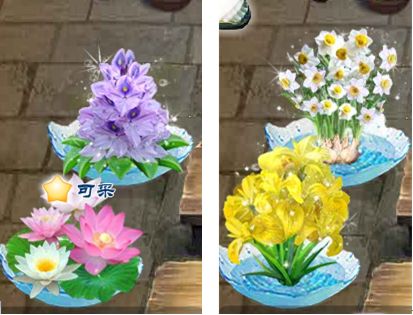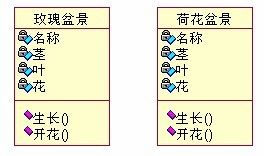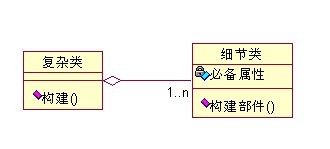生成器模式(又名建造者模式、Builder Pattern)
模式名称:生成器模式
1.问题描述
生活场景:你玩过种地、种花等类似的游戏吗?这是最近很流行的游戏哟!下面就是从种花游戏中剪切的四个花盆(盆景),很漂亮吧!你将不同的种子放入花盆,一段时间后你就可以看到各种美丽的鲜花了,不同种子所生产出来的鲜花有不同的花朵、叶子和枝茎。编码该如何实现呢?
设计目标:将种子放入花盆,一段时间后就可以收获美丽的鲜花!
2.不假思索的思路:将盆景看做一个类,有几个盆景我new几个对象,直接完成这一奇妙过程。
设计类图:
/**
* 荷花盆景
*/
public
class
WaterlilyFlowerpot {
public
String name;
//
茎
public
String stem;
//
叶
public
String leaf;
//
花
public
String flower;
public
void
grow(){
//
说明种类
name
=
"
荷花
"
;
//
生产茎
stem
=
"
40厘米
"
;
//
生产叶子
leaf
=
"
圆形
"
;
//
生产花
flower
=
"
白里透红
"
;
}
public
void
create(){
System.out.println(name
+
"
: 茎
"
+
"
-
"
+
stem
+
"
, 叶
"
+
"
-
"
+
leaf
+
"
, 花
"
+
"
-
"
+
flower);
}
}
/**
* 玫瑰盆景
*/
public
class
RoseFlowerpot {
public
String name;
//
茎
public
String stem;
//
叶
public
String leaf;
//
花
public
String flower;
public
void
grow(){
//
说明种类
name
=
"
玫瑰
"
;
//
生产茎
stem
=
"
20厘米
"
;
//
生产叶子
leaf
=
"
椭圆形
"
;
//
生产花
flower
=
"
大红大白
"
;
}
public
void
create(){
System.out.println(name
+
"
: 茎
"
+
"
-
"
+
stem
+
"
, 叶
"
+
"
-
"
+
leaf
+
"
, 花
"
+
"
-
"
+
flower);
}
}
/**
* 场景类
*/
public
class
Client {
public
static
void
main(String[] args){
//
开始种玫瑰花
RoseFlowerpot rfp
=
new
RoseFlowerpot();
rfp.grow();
//
盛开
rfp.create();
//
玫瑰 : 茎 - 20厘米 , 叶 - 椭圆形 , 花 - 大红大白 半径5厘米
//
开始种荷花
WaterlilyFlowerpot wf
=
new
WaterlilyFlowerpot();
wf.grow();
//
盛开
wf.create();
//
荷花 : 茎 - 40厘米 , 叶 - 圆形 , 花 - 白里透红 半径10厘米
}
}
缺点:
耦合性强,并且有大量代码是重复的。如果想对叶子做一些修改,茎和花的代码也要跟着重写。在这个例子中你可能觉得写一写茎和花的也不费什么事,可真要是想写出像图片中那么漂亮的鲜花的话,每一部分的代码都是很多的,并且这些代码都放在在盆景类中,会让盆景这个类显得很臃肿。那么怎么改?
3.归纳阶段:
耦合性强就要解耦,代码臃肿就要简化和分离。我们需要将盆景这个复杂的类分解成相对简单的类,比如将花盆和鲜花分离,使得同样的花盆可以生长出不同的鲜花,然后再将鲜花分成几个简单的类,使得某一部分的修改不影响其他部分;这也就是生成器模式。 其定义:Separate the construction of a complex object from its representation so that the same construction process can create different representations.(将一个复杂对象的构建与它的表示分离,使得同样的构建过程可以创建不同的表示。)
结构类图:
/**
* 花朵的茎
*/
public
class
Stem {
private
String name
=
"
茎
"
;
private
String length;
public
Stem(){
this
.length
=
"
5厘米
"
;
}
public
Stem(String length){
this
.length
=
length;
}
public
String getName() {
return
name;
}
public
String getLength() {
return
length;
}
}
/**
* 叶子
*/
public
class
Leaf {
private
String name
=
"
叶
"
;
private
String shape;
public
Leaf(String shape){
this
.shape
=
shape;
}
public
Leaf(){
this
.shape
=
"
圆形
"
;
}
public
String getName() {
return
name;
}
public
String getShape() {
return
shape;
}
}
/**
* 花
*/
public
class
Flower {
private
String name
=
"
花
"
;
private
String color;
private
String radius;
public
Flower(){
this
.color
=
"
大红大白
"
;
this
.radius
=
"
5厘米
"
;
}
public
Flower(String color,String radius){
this
.color
=
color;
this
.radius
=
radius;
}
public
String getName() {
return
name;
}
public
void
setName(String name) {
this
.name
=
name;
}
public
String getRadius() {
return
radius;
}
public
String getColor() {
return
color;
}
}
/**
* 以下属性应该为私有,设为公有纯粹是为了方便说明问题并减少代码量
*
@author
谭鹏飞
*
*/
public
abstract
class
Seed {
public
String name;
//
茎
public
Stem stem;
//
叶
public
Leaf leaf;
//
花
public
Flower flower;
public
abstract
void
grow();
}
/**
* 玫瑰类
*/
public
class
Rose
extends
Seed{
public
Rose(Stem stem,Leaf leaf,Flower flower){
//
说明种类
name
=
"
玫瑰
"
;
//
生产茎
this
.stem
=
stem;
//
生产叶子
this
.leaf
=
leaf;
//
生产花
this
.flower
=
flower;
}
public
Rose(Stem stem){
this
(stem,
new
Leaf(),
new
Flower());
//
说明种类
name
=
"
玫瑰
"
;
}
public
Rose(){
this
(
new
Stem(),
new
Leaf(),
new
Flower());
//
说明种类
name
=
"
玫瑰
"
;
}
public
void
grow(){
System.out.println(name
+
"
:
"
+
stem.getName()
+
"
-
"
+
stem.getLength()
+
"
,
"
+
leaf.getName()
+
"
-
"
+
leaf.getShape()
+
"
,
"
+
flower.getName()
+
"
-
"
+
flower.getColor()
+
"
半径
"
+
flower.getRadius());
}
}
/**
* 场景类
*/
public
class
Client {
public
static
void
main(String[] args) {
//
TODO Auto-generated method stub
Seed rose
=
new
Rose();
Soil soil
=
new
Soil(rose);
soil.create();
//
玫瑰 : 茎 - 5厘米 , 叶 - 圆形 , 花 - 大红大白 半径5厘米
}
}
设计体会:
世界上没有两片完全相同的树叶,将构建具体树叶的细节与构建树的表示分离,从而避免了为修改一片树叶而重写了一棵树的麻烦!
4.验证阶段
让上例中的玫瑰的茎再长高5厘米,而不改动叶子和花部分的代码。除场景类外,其他类均不变化,重复代码不再赘述。
/**
* 场景类
*/
public
class
Client {
public
static
void
main(String[] args) {
//
如果你想将花朵长高一点,其它部分不变,没问题,而且改动也不多
Stem stem
=
new
Stem(
"
10厘米
"
);
Seed tallrose
=
new
Rose(stem);
soil
=
new
Soil(tallrose);
soil.create();
//
玫瑰 : 茎 - 10厘米 , 叶 - 圆形 , 花 - 大红大白 半径5厘米
}
}
5.抽象描述
思路描述:
该模式的核心就是分离细节、推迟细节的现实。上面用类来实现细节的分离只是一个小例子 ,你也可以用抽象方法,将细节推迟到子类实现等。不管你用什么方法分离出了细节,再组合回来的时候,你又可以增加许多的操作,比如各个部分的比例、顺序等。生成器模式本身需要和其他模式结合使用,最经常结合的就是模板模式(用于生成具体的子类),其他要根据实际情况而定。
类结构图:



